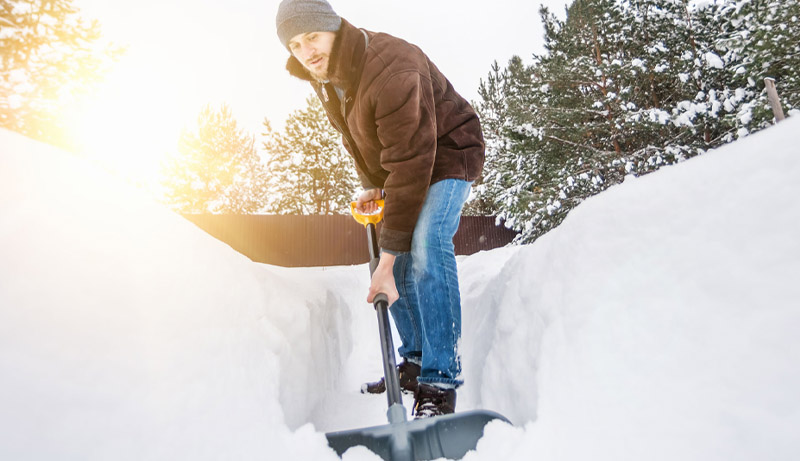Can Winter Weather Ruin Your New Year?

A pretty snowfall blanketing everything in sight when looking out the window is picture perfect. When you are digging out your car from an overnight snowstorm, however, it may put a whole new spin on how you view that winter weather.
Urgent Care versus Emergency Department
Dr. John Kulin, director of Shore Urgent Care in Northfield, said winter weather definitely brings in more patients with fractures, sprains and contusions associated with slips and falls on the ice and snow. X-rays are available on-site at Shore Urgent Care. “Patients with more significant injuries such as head injuries, major trauma or extremity injuries with significant deformity should go to the Emergency Department. Otherwise, urgent care is the best place for most,” said Dr. Kulin.
Be Prepared
The most important things you should do to stay safe during the winter months is be prepared and use common sense. Dr. Kulin suggested having food and water available should there be a power outage and have contact information at hand with a plan of where to go if you should lose power and heat. Make arrangements for snow removal prior to a storm. Have heating equipment properly maintained annually and do not go out in a storm or immediately after unless it is absolutely necessary.
Weekend Warriors
Saturday and Sunday hours at Shore Urgent Care do see an increase of patients who have hit the slopes on their skis and snowboards and then return home, seeking care closer to home, according to Dr. Kulin. Broken fingers and wrists can be taken care of in the office if the deformity from the break is not too severe.
Dr. Kulin said, “We X-ray to rule out a break and then go with the normal resting, elevating and icing the affected area. Typically, these patients will be examined and an X-ray ordered to rule out a fracture or break. Depending on the extent of the injury, it may require anti-inflamatories or splinting, immobilization and crutches along with follow-up with their primary care provider or a specialist to assess proper healing.”
Be Wary of Chest Pains and Shortness of Breath
In the winter months, Shore Urgent Care does experience an uptick in patients with complaints of chest pains and shortness of breath. “Chest pains and shortness of breath are common complaints in the urgent care setting and among the most difficult to deal with,” said Dr. Kulin. “There are many causes for chest pain or shortness of breath, some minor and some life threatening. The patient’s past medical history is a good indicator. If a patient has a history of asthma but has run out of their inhaler, this is a safe and easy visit to the urgent care. On the other hand, when a person is having chest pain, heaviness or shortness of breath after exertion, it is very concerning for a serious heart related issue.”
Dr. Kulin explained that most new onset chest pain or shortness of breath without definite cause is problematic. Chest pain or shortness of breath after exertion should be evaluated in the emergency department, according to Dr. Kulin who added that patient’s safety is always paramount.
Bears Hibernate but People Should Not
All too often a rather sedentary lifestyle is adopted in the winter. But the winter can also bring the region wet and heavy snowfall. Dr. Kulin advises those who are not active to avoid heading out to shovel snow. “Shoveling snow is a labor-intensive activity, especially heavy and wet snow. But if you cannot get someone to shovel for you, then work slowly and deliberately, tackling the job in small increments. Do NOT ‘work up a sweat’ or try to elevate your heart rate. If you develop any shortness of breath, chest heaviness, tightness or pain especially if it radiates to the back, neck or arms, stop immediately and call 911,” said Dr. Kulin.
Carbon Monoxide Poisoning
Winter weather also means the heater and the fireplace will likely be in use. Dr. Kulin said typically they will see patients at Shore Urgent Care who are complaining of headache or nausea that are not related to any cold or flu but related to improper ventilation or a blocked chimney or heating duct. “Everyone needs to remember that carbon monoxide monitors should be used if you have any type of combustible heat such as oil, gas- especially non-vented, kerosene or wood. Carbon monoxide is odorless, tasteless, and colorless.” He said common causes of carbon monoxide poisoning include: malfunctioning cooking appliances, clogged chimney, auto exhaust or idling vehicles, or malfunctioning oil, wood, gas or coal furnaces. Likewise, it could result from a malfunctioning clothes dryer, wood burning fireplace, gas log burner or any unvented space heater, gas or fuel burning appliances in cabins or campers, barbecue grills, ceiling mounted heating units, and pool or spa heaters.
Carbon monoxide poisoning occurs when carbon monoxide builds up in your bloodstream. When too much carbon monoxide is in the air, your body replaces the oxygen in your red blood cells with carbon monoxide. This can lead to serious tissue damage, or even death. A simple plug-in carbon monoxide monitor will detect the presence of carbon monoxide build-up.
Shore Urgent Care is located at 2605 Shore Road in Northfield, New Jersey. Hours are Monday through Friday 8 a.m. to 8 p.m. and Saturday and Sunday, 9 a.m. to 5 p.m. Telehealth visits are also available by calling 609-365-5333 and the patient service representative will inform you of the next steps. Drug screening is available Monday through Friday, 10 a.m. to 5 p.m.